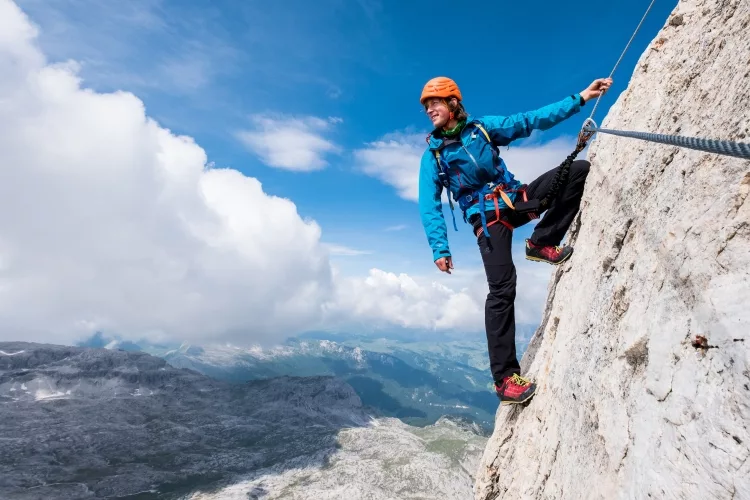Klettersteig, which is known better as via ferrata, represents a protected, safe route for climbing, which you can find in the Alps and some other locations.
The key feature of via ferrata is a steel cable which runs along the rock and which is, with intervals between 3 and 10 meters, fixed to the mountain. Climbers are able to secure themselves against the fall by clinging to the cable with the help of via ferrata kit.

Since 1970s, via ferrata has gained popularity among many climbers, even though at that time there were only a few classic routes (like the Northern Limestone Alps and the Dolomites). Later, the climbing communities started to develop new routes. At the beginning of XXI century, commercial companies appeared that started to create new routes and offer their services to climbers. Since then, this type of sport has started to attract millions and millions of new climbers. However, there are some pieces of advice you should consider before heading to the Alps or other locations offering the services of Klettersteig. Take a look at them below.
1. In the first place, do your best in order to not fall off. Indeed, it may seem obvious, but there are several points why it matters so. The first aspect is that it is much more likely to fall off when doing via ferrata than typical rock climbing. Special Klettersteig lanyards will take a bigger part of energy during a fall, but you will still feel a great impact force once you reach the stop. The second aspect is that you can collide with the things, such as protrusive rocks, rock ledges, ladders, and stemples that were used for creating the via ferrata route itself, when bouncing off. Just keep in mind that in case you fall, the lanyards will just save you. Yet, you can get serious injuries, and therefore, you must do your best in order to prevent falling off.
2. As well, you need the proper equipment for via ferrata, and you should have backup gear. It is not a very rare thing to see that some people climbing via ferrata somewhere in the Northern Limestone Alps without having appropriate gear, usually just using several quickdraws and/or carabiners as well as rock climbing slings. However, such weak protection will not save them in a case of falling off, because it will not be able to take the factors of falling involved. Therefore, you should always wear the gear that was designed especially for via ferrata, which is expensive and quite complex, but capable of stopping your fall.
3. By the way, it is a good idea to have a rope of 25-30 meters with you. In addition, each person from your group should have several spare slings, four screw gate carabiners, a few prussic loops, and a belay device. This gear will appear to be quite helpful when some person looks for getting roped up or for abseiling without difficulties.
4. The next point is that you should check the weather before heading to a via ferrata route ; the majority of the routes are placed high in the mountains, and the weather can be quite capricious there. You have to prepare all the necessary gear and clothes in order to deal with shifts in the weather conditions. Besides, keep in mind that via ferrata routes may appear rogue and dangerous after getting wet.
In addition, thunderstorms along with lightings can appear quite quickly in the mountains, and in such weather conditions, you should not be connected affixed to the route's metal cable. This may be quite difficult, and you will have to think twice how to get out of such situation.
5. In addition to the above-listed aspects, try to start your way very early. Many via ferrata routes may get very busy with myriads of people unhurriedly climbing up. You can find such things quite disappointing. Starting your way early will help you to avoid crowds of other climbers. Moreover, it will be also beneficial, because thunderstorms usually take place in the afternoon. Not a bad reason to start in the early morning, right?
6. After all, during your Klettersteig journey you should be always careful and attentive. Watch out for stones. Be careful and do not displace rocks by your legs onto people who are below you. However, yell a warning in case if you did it. Depending on the place of your route, shout "rock" (American English), "below" (English), "Stein" (German), and "sasso!" (Italian). Get closer to the mountain and do not look up in case if you heard any of such warnings. In some via ferrata routes, such as the Dolomites, there are many sections involving much scree. Therefore, you must always attentively watch out for any rocks. Never forget to wear a helmet.
Klettersteig is an amazing type of sport, and you must try it out at least once, but at the same time, you must always stick to the above-mentioned pieces of advice.
 |
 |
 |
 |
Recent Post
Try the new FREE GiveAways Page
Something wrong ? Try refresh this page
Whitelist, remove adblock to see all the secrets. Once done, hit refresh button below.
 |
 |
 |
 |